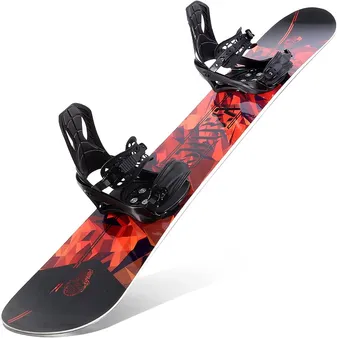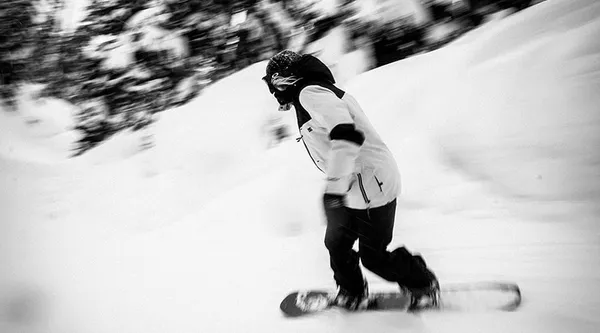Table of Contents
Welcome to Kizworld, the ultimate destination for all your snowboarding needs. Embark on an exhilarating journey to find the perfect snowboard that elevates your riding experience to new heights. With our comprehensive guide, you'll learn the art of matching your skill level and riding style with the ideal snowboard. From deciphering snowboard types and camber options to analyzing size, flexibility, and advanced features, we've got you covered. Get ready to conquer the slopes in style and make every ride a memorable one.
How to Choose the Right Snowboard for Your Skill Level and Style
I. Choosing the Right Snowboard for Your Skill Level and Style
Choosing the Right Snowboard for Your Skill Level and Style
Matching Your Skill Level with the Ideal Camber
The type of camber plays a crucial role in determining a snowboard's performance. If you're new to snowboarding, we recommend opting for a flat or rocker camber. These boards offer better stability and control, allowing you to progress more easily. Once you gain more confidence and experience, you can consider switching to a camber or hybrid camber snowboard for increased responsiveness and edge hold.
- Flat Camber: Minimal bend, provides stability for beginners.
- Rocker Camber: Reverse bend, enhances floatation in powder.
- Camber Camber: Traditional bend, offers pop and edge control.
- Hybrid Camber: Combination of camber and rocker, provides versatility.
Learn more about different types of snowboard camber and their impact on your riding experience.
Selecting the Optimal Snowboard Size
Finding the right snowboard size is crucial for comfort and performance. As a general rule, taller riders require longer boards, while shorter riders can opt for shorter boards. The traditional method involves standing the board on its side next to you, with the tip of the board reaching your nose. However, this method may not be accurate for all body types and riding styles. To ensure a precise fit, we recommend visiting a reputable snowboard shop for a professional sizing consultation.
Height (cm) | Snowboard Length (cm) |
|---|---|
150 - 165 | 135 - 145 |
165 - 180 | 145 - 155 |
180 - 195 | 155 - 165 |
195 - 210 | 165 - 175 |
Read more about choosing the right snowboard size to ensure a comfortable and enjoyable riding experience.
II. Factors to Consider When Choosing a Snowboard
Factors to Consider When Choosing a Snowboard
Choosing the right snowboard is crucial for an enjoyable and safe snowboarding experience. Here are key factors to consider when making your selection:
- Skill Level: Consider your snowboarding proficiency. If you're a beginner, opt for a forgiving board that's easy to control. As you progress, you can move to a more advanced board that offers better performance.
- Riding Style: Different boards are designed for various riding styles. Freeride boards excel in open terrain, while freestyle boards are ideal for tricks and jumps. All-mountain boards offer a versatile blend of both styles.
- Terrain: Think about the type of terrain you'll be riding. If you'll mostly be on groomed slopes, a softer board with a shorter turning radius is suitable. For off-piste adventures, a stiffer board with a longer turning radius provides better stability.
Additional Considerations:
- Board Length: Generally, taller riders need longer boards, while shorter riders can opt for shorter boards. However, your weight and riding style also influence the ideal board length.
- Board Width: A wider board offers more stability and floatation in powder, while a narrower board is more agile and responsive.
- Camber: Camber refers to the board's curvature. A traditional camber provides good edge hold and pop, while a rocker camber is more forgiving and easier to maneuver.
- Flex: Flex refers to the board's stiffness. A stiffer board is more stable at high speeds and provides better edge hold, while a softer board is more forgiving and easier to control.
Making the Final Decision:
Consider all these factors and try out different boards before making a purchase. It's worth investing in a quality snowboard that suits your needs and riding style. Remember, the right snowboard can significantly enhance your snowboarding experience.
Related Posts:
- How to Choose the Right Snowboard for Your Skill Level and Style
- The Benefits of Snowboarding for Fitness and Fun
- The Best Snowboarding Equipment and Accessories
III. Different Types of Snowboards
Different Types of Snowboards
Snowboards come in various designs, each tailored to different riding styles and skill levels. Here's a breakdown of popular snowboard types:
- Freestyle Snowboards: Designed for park and jibbing, they prioritize maneuverability and playfulness, with a softer flex and twin-tip shape.
- All-Mountain Snowboards: As the name suggests, these versatile boards are suitable for all terrains, offering a balanced blend of performance and comfort.
- Freeride Snowboards: These wide, stiff boards excel in off-piste and powder conditions, offering stability and control in challenging terrains.
- Splitboards: For backcountry adventurers, splitboards can be separated into two halves for hiking uphill and reassembled for the descent.
- Alpine Snowboards: Meant for high-speed carving and racing, these narrow, stiff boards prioritize stability and edge control.
When selecting a snowboard, consider your riding style, skill level, and the terrain you'll primarily encounter. Take the snowboard selector test to find the perfect match for your needs.
No matter your choice, proper maintenance is essential to ensure a smooth and enjoyable riding experience.
Snowboard Type | Characteristics |
Freestyle Snowboards | Soft flex, twin-tip shape, maneuverable |
All-Mountain Snowboards | Versatile, balanced performance, suitable for all terrains |
Freeride Snowboards | Wide, stiff, excels in off-piste and powder conditions |
Splitboards | Separable for hiking uphill, reassembled for descent |
Alpine Snowboards | Narrow, stiff, prioritize stability and edge control |
IV. Tips for Choosing the Right Snowboard
Tips for Choosing the Right Snowboard
Choosing the right snowboard is crucial for an enjoyable and safe snowboarding experience. Consider these factors to find the perfect board for your skill level and style:
- Skill Level:
- Beginners: Look for a forgiving board with a soft flex and a wide shape for stability.
- Intermediate: Choose a board with a medium flex and a directional shape for better control and maneuverability.
- Advanced: Opt for a stiff board with a camber profile for precise turns and high-speed riding.
Riding Style:
- Freestyle: Choose a twin-tip board with a soft to medium flex for tricks and jumps.
- Freeride: Select a directional board with a stiffer flex for all-mountain riding and powder.
- Alpine: Go for a carving board with a stiff flex and a camber profile for fast, precise turns.
Board Length:
Generally, your snowboard should reach between your chin and nose when standing upright. Shorter boards are more maneuverable, while longer boards provide more stability.
Board Width:
Wider boards offer more stability and floatation in powder, while narrower boards are more responsive and easier to turn.
Camber Profile:
- Camber: Provides good edge hold and pop, but can be less forgiving for beginners.
- Rocker: Offers a more forgiving ride and better floatation in powder, but may lack edge hold on hardpack.
- Hybrid: Combines camber and rocker profiles for a versatile ride.
Flex:
Flex refers to the stiffness of the board. A softer flex is more forgiving and easier to maneuver, while a stiffer flex provides more stability and control.
Additional Considerations:
- Bindings: Choose bindings that match your boot size and riding style.
- Boots: Ensure your boots fit snugly and provide good support.
- Helmet: Always wear a helmet while snowboarding for safety.
- Goggles: Protect your eyes from the sun and snow with a pair of goggles.
By considering these factors and seeking advice from s, you can find the perfect snowboard that matches your skill level, riding style, and preferences.
Related Posts:
- How to Choose the Right Surfboard for Your Skill Level and Style
- How to Choose the Right Skateboard for Your Skill Level and Style
- How to Choose the Right Ski Boots for Your Skill Level and Style
V. Conclusion
With the knowledge gained from this comprehensive guide, you're now empowered to make an informed decision when choosing the perfect snowboard that matches your skill level and riding style. Remember, the ideal snowboard is one that complements your abilities, enhances your riding experience, and allows you to progress safely and confidently. Embrace the thrill of the slopes with a snowboard that becomes an extension of your snowboarding journey, unlocking new levels of enjoyment and pushing the boundaries of your riding prowess.